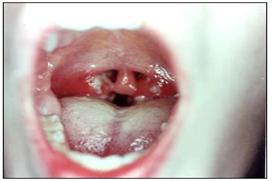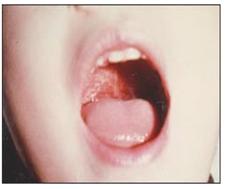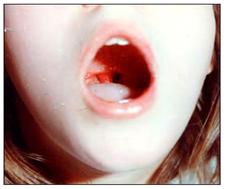편도 주위 농양 Peritonsillar abscess

그림 76. 심한 급성 편도염으로 양쪽 편도가 심하게 감염되었다.
Copyright ⓒ 2011 John Sangwon Lee, M.D., FAAP
편도 주위 농양의 원인
-
A군 베타 용혈성 연쇄상구균 등 유산소성(호기성) 박테리아나 무산소성(염기성) 박테리아 등이 편도 주위에 감염되어 생긴 염증을 편도 주위 농양이라고 한다.
-
대부분의 편도 주위 농양은 급성 편도염을 일으켰던 원인균이 편도 주위로 감염되어 거기에 농양이 생긴다.
-
인두 후부 농양은 영아들에게 더 잘 생기지만 편도 주위 농양은 사춘기가 되기 이전 학령기 아이들이나 사춘기 아이들에게 더 잘 생길 수 있다.
-
여러 종류의 박테리아 감염으로 편도 주위 농양이 생길 수 있지만 A군 베타 용혈성 연쇄상구균이 가장 잘 일으킨다.
-
드물게 황색 포도상구균이나 B형 헤모필러스 인플루엔자균, 또는 박테로이드균 등의 박테리아가 이 병을 일으킬 수 있다.
-
편도 주위 농양은 비교적 흔한 병이다. 편도 절제 수술 참조
편도 주위 농양의 증상 징후
-
A군 베타 용혈성 연쇄상구균이 급성 편도염을 일으킨 후 그 세균이 편도 주위로 감염되어 편도 주위 농양을 일으킬 수 있다.
-
또 급성 편도염이 다 나아 가다가 한쪽 편도나 양쪽 편도와 편도 주위가 갑자기 붓고 아프면서 고열이 나면서 곪을 수 있다.
-
A군 β 용혈성 연쇄상구균 감염으로 생긴 편도염을 앓을 때보다 목안이 더 심하게 아프고 고열이 나는 것이 보통이다.
-
음식물을 씹고 삼킬 때나 입을 벌리고 말할 때도 편도 주위 농양이 나 있는 쪽 목안이 더 몹시 아프다.
-
그쪽의 입을 마음대로 크게 벌리기가 어렵고 편도 주위 농양이 생긴 쪽 턱 밑에 있는 목 림프절이 붓고 아픈 것이 보통이다.
-
이 병을 적절히 빨리 치료하지 않으면 편도 주위 농양이 있는 쪽 편도와 인두와 그 주위가 몹시 붓고 기도가 좁아질 수 있다.
-
목젖은 편도 주위 농양이 있는 반대쪽으로 밀려갈 수 있고 목젖도 감염될 수 있다.
-
급성 인두염도 동시 생겨 있을 수 있다.

그림 77. 오른쪽 편도에 편도염도 있고 편도 주위 농양이 생겨 우 편도가 빨갛게 부었다.
Copyright ⓒ 2011 John Sangwon Lee, M.D., FAAP

그림 78. 오른쪽 편도 주위에 생긴 편도 주위 농양. 편도가 붓고 목젖이 붉고 부어 있다.
Copyright ⓒ 2011 John Sangwon Lee, M.D., FAAP
편도 주위 농양의 진단 치료
-
병력·증상 징후·진찰소견·목 인두 부위 초음파 검사 결과 등을 종합하여 이 병을 비교적 쉽게 진단할 수 있다.
-
면봉으로 인두 점막층이나 편도 점막층의 점액을 조금 채취하여 그 피검물로 세균배양검사를 해서 어떤 종류의 박테리아 감염으로 이 병이 생겼는지 알아본다.
-
편도 주위 농양을 일으킨 박테리아가 인두 부위로, 또 농양이 생긴 편도의 위아래 좌우 부위로 점점 더 감염될 수 있고, 전신으로 감염되 생명을 위협할 수 있는 패혈증이나 다른 종류의 2차 세균 감염성 합병증이 생길 수 있다.
-
이 병은 병원 중환자 치료실에서 응급으로 받아야한다.
-
적절한 항생제 정맥주사로 응급 치료한다.
-
항생제 치료를 받는 동안 편도 주위 농양 속 고름을 수술로 배농시키고, 항생제로 완전히 치료 한 후 몇 주 후 적절한 시기에 선택적 편도 절제 수술 치료를 하는 것이 보통이다.
-
편도 주위 농양이 한 번 생겼던 편도에 편도 주위 농양이 또 생길 가능성이 더 많이 있기 때문이다.
Peritonsillar abscess 편도 주위 농양

Figure 76. Severe acute tonsillitis with both tonsils severely infected. Copyright ⓒ 2011 John Sangwon Lee, M.D., FAAP
Causes of a peritonsillar abscess
• Inflammation caused by infection around the tonsils with aerobic (aerobic) bacteria or anaerobic (basic) bacteria such as group A beta-hemolytic streptococcus is called a peritonsillar abscess.
• Most of the paratonsillitis abscesses are caused by the infection around the tonsils with the bacteria that caused acute tonsillitis.
• Posterior pharyngeal abscesses are more common in infants, but paratonsillar abscesses are more likely to develop in pre-pubertal school-age children or adolescents.
• Several types of bacterial infection can cause peritonsillar abscesses, but group A beta-hemolytic streptococci are the most common.
• Rarely, bacteria such as Staphylococcus aureus, Haemophilus influenzae B, or Bacteroides can cause this disease.
• A peritonsillar abscess is a relatively common disease. See tonsillectomy surgery
Signs, symptoms of a peritonsillar abscess
• After group A beta-hemolytic streptococci cause acute tonsillitis, the bacteria can infect the tonsils and cause a peritonsillar abscess.
• Also, as acute tonsillitis progresses, one or both tonsils and the area around the tonsils may suddenly become swollen and painful, and a high fever may occur.
• It is common to have a sore throat and high fever more than when you have tonsillitis caused by a group A β-hemolytic streptococcal infection.
• Throat pain on the side with the abscess around the tonsils is worse when chewing, swallowing, or talking with the mouth open.
• It is difficult to open the mouth wide on that side, and it is common to have swollen and painful neck lymph nodes under the jaw on the side where the paratonsillar abscess occurred.
• If the condition is not treated promptly and appropriately, the tonsils and pharynx on and around the side with the paratonsillar abscess can become very swollen and the airways can be narrowed.
• The uvula may be pushed to the opposite side of the peritonsillar abscess and the uvula may become infected.
• Acute pharyngitis may also co-occur.

Figure 77. I also have tonsillitis on my right tonsil and a peritonsillar abscess, which causes my right tonsil to become red and swollen. Copyright ⓒ 2011 John Sangwon Lee, M.D., FAAP

Figure 78. A peritonsillar abscess around the right tonsil. The tonsils are swollen and the uvula is red and swollen. Copyright ⓒ 2011 John Sangwon Lee, M.D., FAAP
Diagnosis, treatment of a peritonsillar abscess
• This disease can be diagnosed relatively easily by combining the medical history, symptom signs, examination findings, and ultrasound examination results of the throat and pharynx.
• Take a small amount of mucus from the pharyngeal mucosa or tonsils with a cotton swab and perform a bacterial culture test with the specimen to find out what kind of bacterial infection caused the disease.
• The bacteria causing the paratonsillar abscess can increasingly infect the pharynx and to the upper, lower, left, and right areas of the abscessed tonsil, and systemic, life-threatening sepsis or other secondary bacterial infectious complications. can happen
• This illness must be treated in an emergency room in the hospital’s intensive care unit.
• Provide emergency treatment with appropriate intravenous antibiotics.
• During antibiotic treatment, it is common to surgically drain the pus in the abscess around the tonsils, and after a few weeks of complete antibiotic treatment, selective tonsillectomy surgery is performed at an appropriate time.
• Because the tonsils that have had one peritonsillar abscess are more likely to have another peritonsillar abscess.
출처 및 참조 문헌 Sources and references
- NelsonTextbook of Pediatrics 22ND Ed
- The Harriet Lane Handbook 22ND Ed
- Growth and development of the children
- Red Book 32nd Ed 2021-2024
- Neonatal Resuscitation, American Academy of Pediatrics
- www.drleepediatrics.com 제 6권 신생아 성장 발육 육아 질병
-
www.drleepediatrics.com제7권 소아청소년 감염병
- www.drleepediatrics.com제8권 소아청소년 호흡기 질환
- www.drleepediatrics.com제9권 소아청소년 소화기 질환
- www.drleepediatrics.com제10권. 소아청소년 신장 비뇨 생식기 질환
- www.drleepediatrics.com제11권. 소아청소년 심장 혈관계 질환
- www.drleepediatrics.com제12권. 소아청소년 신경 정신 질환, 행동 수면 문제
- www.drleepediatrics.com제13권. 소아청소년 혈액, 림프, 종양 질환
- www.drleepediatrics.com제14권. 소아청소년 내분비, 유전, 염색체, 대사, 희귀병
- www.drleepediatrics.com제15권. 소아청소년 알레르기, 자가 면역질환
- www.drleepediatrics.com제17권. 소아청소년 피부 질환
- www.drleepediatrics.com제18권. 소아청소년 이비인후(귀 코 인두 후두) 질환
- Red book 29th-31st edition 2021
- Nelson Text Book of Pediatrics 19th — 21st Edition
- The Johns Hopkins Hospital, The Harriet Lane Handbook, 22nd edition
-
Childhood Emergencies in the Office, Hospital and Community, American Academy of Pediatrics
-
Emergency Medical Service for Children, By Ross Lab. May 1989. p.10
-
Emergency care, Harvey grant, and Robert Murray
-
Emergency Care Transportation of Sick and Injured American Academy of Orthopaedic Surgeons
-
Emergency Pediatrics A Guide to Ambulatory Care, Roger M. Barkin, Peter Rosen
-
Immediate care of the acutely ill and injured, Hugh E. Stephenson, Jr
-
The Critically Ill Child, Diagnosis and Management, Edited by Clement A. Smith
-
Emergency Medical Services for Children: The Role of the Primary Care Provider, America Academy of Pediatrics
-
Quick Reference To Pediatric Emergencies, Delmer J. Pascoe, M.D., Moses Grossman, M.D. with 26 contributors
-
Manual of Emergency Care
-
응급환자관리 정담미디어
-
소아가정간호백과–부모도 반의사가 되어야 한다, 이상원
-
Neonatal Resuscitation American heart Association
-
Neonatology Jeffrey J.Pomerance, C. Joan Richardson
-
Pediatric Resuscitation Pediatric Clinics of North America, Stephen M. Schexnayder, M.D.
-
Pediatric Critical Care, Pediatric Clinics of North America, James P. Orlowski, M.D.
-
Preparation for Birth. Beverly Savage and Dianna Smith
- Infectious disease of children, Saul Krugman, Samuel L Katz, Ann A. Gershon, Catherine Wilfert
-
The Harriet Lane Handbook 19th Edition
-
소아과학 대한교과서
-
제1권 소아청소년 응급의료 참조문헌과 출처
- HARVARD MEDICAL SCHOOL, INFECTIOUS DISEASES IN PRIMARY CARE OCTOBER 14-16, 2015
- other
Copyright ⓒ 2015 John Sangwon Lee, MD., FAAP
“부모도 반의사가 되어야 한다”-내용은 여러분들의 의사로부터 얻은 정보와 진료를 대신할 수 없습니다.
“The information contained in this publication should not be used as a substitute for the medical care and advice of your doctor. There may be variations in treatment that your doctor may recommend based on individual facts and circumstances. “Parental education is the best medicine.”